Wallace Reid (1891–1923) was an American actor in the silent film referred to as "the screen's most perfect lover". He debuted at Selig but soon rose to popularity at Vitagraph and Universal. Later he moved to Paramount, where he starred as a dashing daredevil in popular race-car films. A morphine addiction killed him, at the age of only 31.
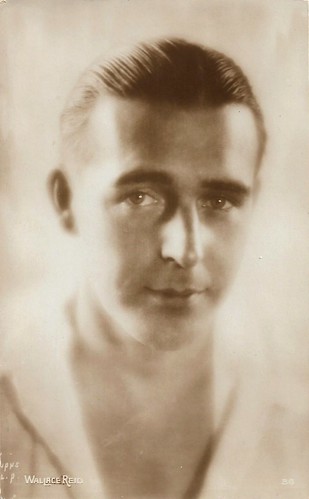
French postcard by Cinémagazine-Edition, no. 36. Photo: Evans, L.A.

British postcard by 'Pictures' Portrait Gallery, London, by Pictures Ltd. London, no. 145.

French postcard by Editions Paramount, Paris.

French postcard in the Les Vedettes du Cinéma series by Editions Filma, no. 58. Photo: Paramount Pictures.
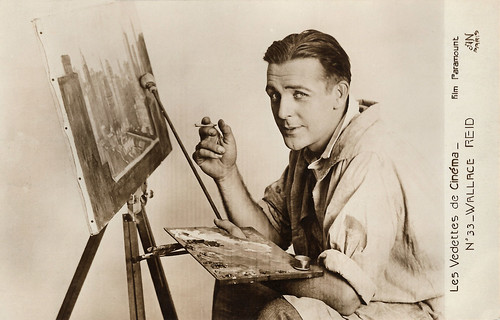
French postcard in the Les Vedettes de Cinéma series by A.N., Paris, no. 33. Photo: Film Paramount.
William Wallace Halleck Reid was born in St. Louis, Missouri, in a vaudeville family in 1891. His mother, Bertha Westbrook, was an actress, and his father, James Halleck "Hal" Reid, worked successfully in a variety of theatrical jobs, mainly as playwright and actor, traveling the country.
As a boy, Wallace Reid was performing on stage at the age of four in the act with his parents, but the acting was put on hold while he obtained his education at Freehold Military School in Freehold Township, New Jersey. He managed a football team and ran the school newspaper. He later graduated from Perkiomen Seminary in Pennsburg, Pennsylvania, in 1909. Wallace was now an all-around athlete and gifted musician.
When his father entered the film business in 1910, he brought along his teenage son who wanted to be a cameraman. However, with his athletic good looks, he was often put in front of the camera instead of behind. In 1910, Reid appeared as a reporter in his first film, The Phoenix (N.N., 1910), an adaptation of a Milton Nobles play, filmed at Selig Polyscope Studios in Chicago.
He was soon acting and directing with and for early film mogul Allan Dwan. Reid played in some 100 shorts. Although Reid's good looks and powerful physique made him the perfect matinée idol, he was equally happy with the roles behind the scenes and often worked as a writer, cameraman, and director.
In 1913, while at Universal Pictures, Reid met and married actress Dorothy Davenport. She was only seventeen, but already a veteran of the stage and screen. Davenport was one of the stars that he both directed and starred with.
Reid had parts in such famous feature films like Birth of a nation (1915) and Intolerance (1916) by D. W. Griffith. He also starred opposite leading ladies such as Florence Turner, Gloria Swanson, Lillian Gish, Elsie Ferguson, and Geraldine Farrar en route to becoming one of Hollywood's major heartthrobs.

Vintage postcard. Photo: Hoover Art Co.

Italian postcard by B & G B, no. 83. Photo: Paramount Pictures.
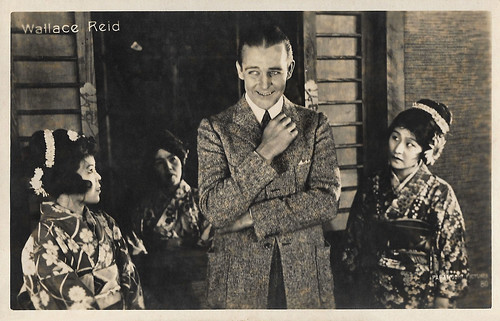
Italian postcard by G. Vettori, Bologna, no. 80. Photo: Paramount Pictures.

Swedish postcard by Förlag Nordisk Konst, Stockholm, no. 978. Photo: Skandinavisk Filmcentral, Stockholm.
Then Reid was signed by producer Jesse L. Lasky for some 60 more films at Lasky's Famous Players film company, which later became Paramount Pictures. Wallace went on to star in a series of pictures in which he represented all that was best of the ideal American.
His action-hero role as the dashing race-car driver drew young girls and older women alike to theatres to see his daredevil auto thrillers such as The Roaring Road (James Cruze, 1919) with Ann Little, Double Speed (Sam Wood, 1920), Excuse My Dust (Sam Wood, 1920), and Too Much Speed (Frank Urson, 1921). Reid was so fond of racing that he even joined an Indianapolis race in 1922.
En route to Oregon for the filming of The Valley of the Giants (James Cruze, 1919), Reid was injured in a train wreck near Arcata, California, and needed six stitches to close a three-inch scalp wound. He was prescribed morphine for relief of his excruciating pain so he could continue filming. Reid soon became addicted but kept on working at a frantic pace in films that were growing more physically demanding and changing from 15–20 minutes in duration to as much as an hour.
Reid became depressed and his alcohol use got out of control, even though he was young, fit, and strong. Reid's morphine addiction worsened at a time when drug rehabilitation programs were nonexistent. Coupled with the alcohol, Wallace never had a chance and by 1922, he started entering a succession of hospitals and sanitariums as his health began to deteriorate rapidly.
Making his last film for the studio, Thirty Days (James Cruze, 1922), Wallace was barely able to stand, let alone act. Wallace Reid died in his wife's arms in a sanitarium in Los Angeles while attempting recovery in 1923. He was only 31. Wallace was the third major Paramount personality to be involved in a scandal in 1922.
His wife, Dorothy Davenport, co-produced and appeared (billed as Mrs. Wallace Reid) in Human Wreckage (John Griffith Wray, 1923). She did a national tour with the film to warn against the dangers of drugs. She and Reid had two children: a son, Wallace Reid Jr., born in 1917; and a daughter, Betty Mummert, whom they adopted in 1922 as a three-year-old. Allegedly Reid had fathered her during an affair. Davenport never remarried.
Wallace Reid's contribution to the film industry has been recognised with a star on the Hollywood Walk of Fame. In 2007, the biography 'Wallace Reid: Life and Death of a Hollywood Idol' by author E. J. Fleming appeared.
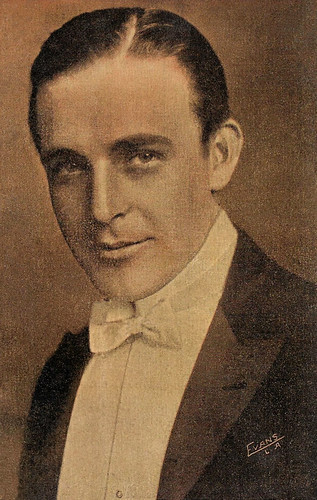
Spanish collector's card by Amatller Marca Luna, series 11, no. 20. Photo: Evans, L.A.
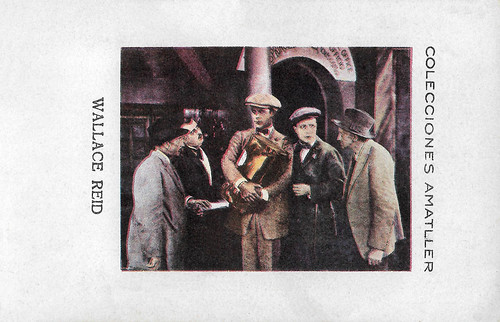
Spanish collectors card by Chocolate Amatller, series CC, artist 35, no. 77. Wallace Reid and Harrison Ford in Hawthorne of the U.S.A. (James Cruze, 1919). It is one of the few surviving films with Reid.
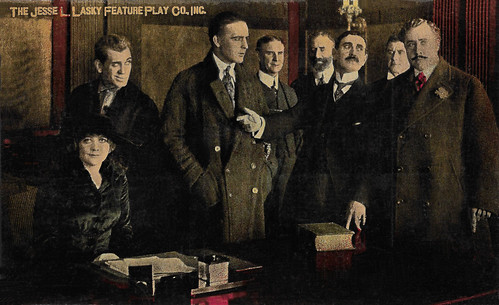
Spanish cromo (colored collectors card) by Chocolat Imperiale, no. 2 of 6 cards. Photo: Jesse Lasky / Paramount. Myrtle Stedman, Wallace Reid, and William Conklin in The Prison Without Walls (E. Mason Hopper, 1917), written by Beulah Marie Dix and Robert E. MacAlarney. The Spanish title for the film was Prisión sin muros.

Spanish cromo (colored collectors card) by Chocolat Imperiale, no. 5 of 6 cards. Photo: Jesse Lasky / Paramount. Myrtle Stedman, and Wallace Reid in The Prison Without Walls (E. Mason Hopper, 1917). The old man may be James Neill.

Spanish cromo (colored collectors card) by Chocolat Imperiale, no. 6 of 6 cards. Photo: Jesse Lasky / Paramount. Myrtle Stedman, Wallace Reid, Camille Ankewich, and William Conklin in The Prison Without Walls (E. Mason Hopper, 1917). The old lady could be Lillian Leighton.
Sources: Tony Fontana (IMDb), Marta Monk (Find-A-Grave), Wikipedia, and IMDb.

French postcard by Cinémagazine-Edition, no. 36. Photo: Evans, L.A.

British postcard by 'Pictures' Portrait Gallery, London, by Pictures Ltd. London, no. 145.

French postcard by Editions Paramount, Paris.

French postcard in the Les Vedettes du Cinéma series by Editions Filma, no. 58. Photo: Paramount Pictures.

French postcard in the Les Vedettes de Cinéma series by A.N., Paris, no. 33. Photo: Film Paramount.
En route to becoming one of Hollywood's major heartthrobs
William Wallace Halleck Reid was born in St. Louis, Missouri, in a vaudeville family in 1891. His mother, Bertha Westbrook, was an actress, and his father, James Halleck "Hal" Reid, worked successfully in a variety of theatrical jobs, mainly as playwright and actor, traveling the country.
As a boy, Wallace Reid was performing on stage at the age of four in the act with his parents, but the acting was put on hold while he obtained his education at Freehold Military School in Freehold Township, New Jersey. He managed a football team and ran the school newspaper. He later graduated from Perkiomen Seminary in Pennsburg, Pennsylvania, in 1909. Wallace was now an all-around athlete and gifted musician.
When his father entered the film business in 1910, he brought along his teenage son who wanted to be a cameraman. However, with his athletic good looks, he was often put in front of the camera instead of behind. In 1910, Reid appeared as a reporter in his first film, The Phoenix (N.N., 1910), an adaptation of a Milton Nobles play, filmed at Selig Polyscope Studios in Chicago.
He was soon acting and directing with and for early film mogul Allan Dwan. Reid played in some 100 shorts. Although Reid's good looks and powerful physique made him the perfect matinée idol, he was equally happy with the roles behind the scenes and often worked as a writer, cameraman, and director.
In 1913, while at Universal Pictures, Reid met and married actress Dorothy Davenport. She was only seventeen, but already a veteran of the stage and screen. Davenport was one of the stars that he both directed and starred with.
Reid had parts in such famous feature films like Birth of a nation (1915) and Intolerance (1916) by D. W. Griffith. He also starred opposite leading ladies such as Florence Turner, Gloria Swanson, Lillian Gish, Elsie Ferguson, and Geraldine Farrar en route to becoming one of Hollywood's major heartthrobs.

Vintage postcard. Photo: Hoover Art Co.

Italian postcard by B & G B, no. 83. Photo: Paramount Pictures.

Italian postcard by G. Vettori, Bologna, no. 80. Photo: Paramount Pictures.

Swedish postcard by Förlag Nordisk Konst, Stockholm, no. 978. Photo: Skandinavisk Filmcentral, Stockholm.
Daredevil auto thrillers
Then Reid was signed by producer Jesse L. Lasky for some 60 more films at Lasky's Famous Players film company, which later became Paramount Pictures. Wallace went on to star in a series of pictures in which he represented all that was best of the ideal American.
His action-hero role as the dashing race-car driver drew young girls and older women alike to theatres to see his daredevil auto thrillers such as The Roaring Road (James Cruze, 1919) with Ann Little, Double Speed (Sam Wood, 1920), Excuse My Dust (Sam Wood, 1920), and Too Much Speed (Frank Urson, 1921). Reid was so fond of racing that he even joined an Indianapolis race in 1922.
En route to Oregon for the filming of The Valley of the Giants (James Cruze, 1919), Reid was injured in a train wreck near Arcata, California, and needed six stitches to close a three-inch scalp wound. He was prescribed morphine for relief of his excruciating pain so he could continue filming. Reid soon became addicted but kept on working at a frantic pace in films that were growing more physically demanding and changing from 15–20 minutes in duration to as much as an hour.
Reid became depressed and his alcohol use got out of control, even though he was young, fit, and strong. Reid's morphine addiction worsened at a time when drug rehabilitation programs were nonexistent. Coupled with the alcohol, Wallace never had a chance and by 1922, he started entering a succession of hospitals and sanitariums as his health began to deteriorate rapidly.
Making his last film for the studio, Thirty Days (James Cruze, 1922), Wallace was barely able to stand, let alone act. Wallace Reid died in his wife's arms in a sanitarium in Los Angeles while attempting recovery in 1923. He was only 31. Wallace was the third major Paramount personality to be involved in a scandal in 1922.
His wife, Dorothy Davenport, co-produced and appeared (billed as Mrs. Wallace Reid) in Human Wreckage (John Griffith Wray, 1923). She did a national tour with the film to warn against the dangers of drugs. She and Reid had two children: a son, Wallace Reid Jr., born in 1917; and a daughter, Betty Mummert, whom they adopted in 1922 as a three-year-old. Allegedly Reid had fathered her during an affair. Davenport never remarried.
Wallace Reid's contribution to the film industry has been recognised with a star on the Hollywood Walk of Fame. In 2007, the biography 'Wallace Reid: Life and Death of a Hollywood Idol' by author E. J. Fleming appeared.

Spanish collector's card by Amatller Marca Luna, series 11, no. 20. Photo: Evans, L.A.

Spanish collectors card by Chocolate Amatller, series CC, artist 35, no. 77. Wallace Reid and Harrison Ford in Hawthorne of the U.S.A. (James Cruze, 1919). It is one of the few surviving films with Reid.

Spanish cromo (colored collectors card) by Chocolat Imperiale, no. 2 of 6 cards. Photo: Jesse Lasky / Paramount. Myrtle Stedman, Wallace Reid, and William Conklin in The Prison Without Walls (E. Mason Hopper, 1917), written by Beulah Marie Dix and Robert E. MacAlarney. The Spanish title for the film was Prisión sin muros.

Spanish cromo (colored collectors card) by Chocolat Imperiale, no. 5 of 6 cards. Photo: Jesse Lasky / Paramount. Myrtle Stedman, and Wallace Reid in The Prison Without Walls (E. Mason Hopper, 1917). The old man may be James Neill.

Spanish cromo (colored collectors card) by Chocolat Imperiale, no. 6 of 6 cards. Photo: Jesse Lasky / Paramount. Myrtle Stedman, Wallace Reid, Camille Ankewich, and William Conklin in The Prison Without Walls (E. Mason Hopper, 1917). The old lady could be Lillian Leighton.
Sources: Tony Fontana (IMDb), Marta Monk (Find-A-Grave), Wikipedia, and IMDb.
No comments:
Post a Comment